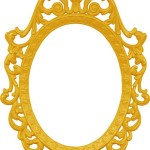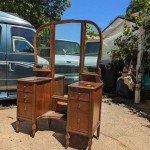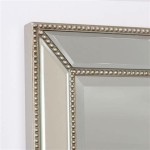Mirrored Side Tables: A Comprehensive Guide to Style, Function, and Placement
Mirrored side tables represent a significant trend in interior design, offering a blend of functionality and aesthetic appeal. These tables, distinguished by their reflective surfaces, have become increasingly popular in diverse settings, from modern minimalist apartments to more traditionally styled homes. This article provides a detailed examination of mirrored side tables, exploring their construction, stylistic variations, practical applications, and considerations for incorporating them effectively into various interior design schemes.
The fundamental characteristic of a mirrored side table is its use of mirrored panels as a primary material. This reflective surface creates an illusion of increased space and enhances the ambient light within a room. The construction typically involves a sturdy internal frame, often made of wood or metal, which provides structural support. Mirrored panels are then carefully affixed to this frame, creating the table’s exterior. The quality of both the frame and the mirror significantly impacts the table's durability and overall aesthetic. High-quality frames prevent warping and structural instability, while well-crafted mirrors offer clarity and resistance to scratches or discoloration.
The style of a mirrored side table can vary considerably, ranging from sleek, contemporary designs to more ornate, vintage-inspired pieces. Contemporary mirrored side tables often feature clean lines, geometric shapes, and minimalist details. These designs prioritize simplicity and functionality, emphasizing the reflective qualities of the mirror to create a sense of openness. Vintage-inspired mirrored side tables, on the other hand, typically incorporate more elaborate details, such as beveled edges, intricate carvings, and antique finishes. These tables often evoke a sense of glamour and sophistication, drawing inspiration from Art Deco or Hollywood Regency styles.
Beyond aesthetics, mirrored side tables offer several practical advantages. Their compact size makes them ideal for smaller spaces, such as apartments or bedrooms, where larger pieces of furniture might overwhelm the room. The reflective surface helps to brighten the space, making it feel more airy and spacious. Furthermore, the smooth surface of the mirror is easy to clean and maintain, requiring only occasional wiping with a damp cloth to remove dust and fingerprints.
The versatility of mirrored side tables allows them to be incorporated into various rooms throughout the home. In the living room, they can serve as a convenient surface for lamps, drinks, or decorative items. In the bedroom, they function effectively as nightstands, providing a stylish and functional storage solution. In hallways or entryways, mirrored side tables can create a welcoming ambiance, reflecting light and adding a touch of elegance. The choice of placement will depend on the specific design and function of the table, as well as the overall aesthetic of the room.
Understanding Material and Construction
The longevity and aesthetic appeal of a mirrored side table are intrinsically linked to the quality of its materials and the precision of its construction. The internal frame, crucial for structural integrity, is typically constructed from either solid wood, engineered wood (such as MDF), or metal. Solid wood offers superior durability and resistance to warping, but it is also the most expensive option. Engineered wood provides a more cost-effective alternative, offering adequate strength and stability when properly constructed. Metal frames, often made of steel or aluminum, offer a sleek, modern aesthetic and are highly resistant to damage.
The mirror itself is another critical component. The quality of the mirror glass directly impacts its clarity, reflectivity, and resistance to scratches and blemishes. High-quality silvered mirrors provide the most accurate reflection and are less prone to discoloration over time. The thickness of the mirror also plays a role in its durability. Thicker mirrors are less likely to crack or chip, particularly along the edges. Beveled edges, a common feature on mirrored furniture, add a touch of elegance and sophistication while also reducing the sharpness of the edges. The method of attaching the mirror panels to the frame is also important. Secure adhesion is essential to prevent the panels from becoming loose or detaching over time.
The finishing touches on a mirrored side table can significantly enhance its overall appearance and durability. A high-quality sealant or protective coating can help to protect the mirror from moisture and other environmental factors. The hardware, such as knobs or handles, should be chosen to complement the style of the table and should be made of durable materials that are resistant to corrosion. The quality of these details can distinguish a well-crafted piece from a cheaper imitation.
Stylistic Considerations for Integrating Mirrored Side Tables
Integrating a mirrored side table into an existing interior design scheme requires careful consideration of the room's overall style and aesthetic. Mirrored furniture can complement a variety of decor styles, but it is important to ensure that the table's design and finish align with the existing elements in the room.
In contemporary spaces, mirrored side tables with clean lines and minimalist details can enhance the sense of openness and light. Pairing them with other contemporary furniture, such as sleek sofas, geometric rugs, and metallic accents, can create a cohesive and stylish look. In more traditional spaces, mirrored side tables with ornate details and antique finishes can add a touch of glamour and sophistication. These tables can be paired with classic furniture, such as upholstered armchairs, carved wooden accents, and vintage-inspired lighting fixtures.
The color palette of the room should also be considered when choosing a mirrored side table. Mirrored furniture reflects the surrounding colors, so it is important to ensure that the table complements the existing color scheme. In rooms with neutral color palettes, mirrored side tables can add a touch of visual interest and depth. In rooms with bolder color palettes, mirrored side tables can help to balance the colors and prevent the room from feeling overwhelming. The surrounding decor and accessories should also be chosen to complement the mirrored surface, avoiding clutter that could detract from the tables' reflective qualities. Thoughtfully curated decorations, such as a vase of flowers or a stack of art books, can enhance the table's visual appeal without overwhelming the space.
The choice of lighting can also significantly impact the appearance of a mirrored side table. Well-placed lighting can accentuate the table's reflective qualities and create a sense of drama. Lamps placed on or near the table can cast a warm glow, while overhead lighting can highlight the table's shape and details. Natural light can also enhance the table's reflective properties, making the room feel brighter and more spacious. Placement near a window or other source of natural light can maximize the table's ability to illuminate the space.
Practical Applications and Placement within the Home
The practical applications of mirrored side tables are diverse, extending beyond mere aesthetic appeal. Their compact size and reflective qualities make them suitable for a variety of roles and spaces within the home.
In living rooms, mirrored side tables can serve as convenient surfaces for lamps, beverages, or decorative objects. They can be placed next to sofas or armchairs, providing easy access to essential items. Their reflective surfaces can also help to create a more inviting and spacious atmosphere. In bedrooms, mirrored side tables can function as stylish nightstands, offering storage for books, reading glasses, or other bedside essentials. Their reflective surfaces can also brighten the room and create a more relaxing ambiance. The size and style of the table should be carefully chosen to complement the existing bedroom furniture and decor. A smaller, more minimalist table may be suitable for a smaller bedroom, while a larger, more ornate table may be more appropriate for a larger room.
In hallways or entryways, mirrored side tables can create a welcoming and elegant ambiance. They can be placed against a wall or in a corner, providing a surface for keys, mail, or other items. Their reflective surfaces can also help to brighten the space and create a more inviting entrance. The addition of a decorative mirror above the table can further enhance the entryway's style and functionality. In bathrooms, smaller mirrored side tables can provide a convenient surface for toiletries or decorative items. However, it is important to choose tables that are specifically designed for use in humid environments to prevent damage to the mirror or frame. Proper ventilation and regular cleaning are also essential to maintain the table's appearance and longevity.
When placing a mirrored side table, it is important to consider the surrounding environment and the potential impact of its reflective surface. Avoid placing the table in direct sunlight, as this can cause the mirror to overheat and potentially damage the frame. Also, be mindful of the objects that will be reflected in the mirror, as cluttered or unsightly items can detract from the table's aesthetic appeal. Carefully curated decorations and accessories can enhance the table's visual impact without overwhelming the space.
Diamond Bedside Table Tables

Celeste Mirrored Bedside Table All Home Living

Home Décor Affordable Modern Furniture Mirrored Bedroom Side Table Decor

Silver Mirrored Bedside Table Classic Collection

Mirrored Pedestal Side Table Nightstand Urban Outfitters

Ikifly Mirrored Nightstand W 3 Drawers Mirror Accent Side Table Finished End For Living Room Bedroom Com

Knightbridge Mirrored Side Table Rose Gold

Noble House Amy Mirrored Side Table Clear Com

Azul Mirrored Side Table

Addison Silver Mirrored Side Table








